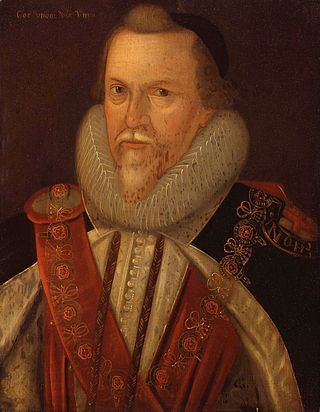
Thomas Cecil, 1st Earl of Exeter, KG, known as Lord Burghley from 1598 to 1605, was an English politician, courtier and soldier.
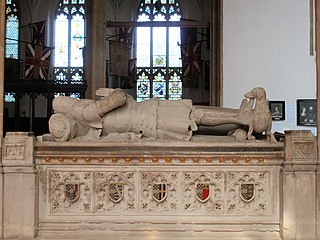
Sir Robert Drury (1456–1536) was an English knight, Lord of the Manor of Hawstead, Suffolk, and Knight of the Body to Kings Henry VII and Henry VIII. As a politician he was Knight of the Shire for Suffolk, Speaker of the House of Commons, and Privy Councillor. He was also a barrister-at-law. His London townhouse was on the site of today's Drury Lane.
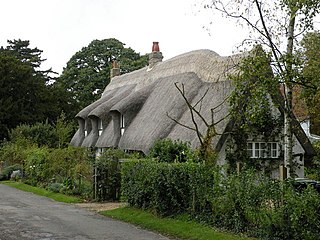
Balsham is a rural village and civil parish in the county of Cambridgeshire, England, which has much expanded since the 1960s and is now one of several dormitory settlements of Cambridge. The village is south east of the centre of Cambridge beyond the A11 road and near Newmarket and Haverhill where many residents work and shop.

A monumental brass is a type of engraved sepulchral memorial once found through Western Europe, which in the 13th century began to partially take the place of three-dimensional monuments and effigies carved in stone or wood. Made of hard latten or sheet brass, let into the pavement, and thus forming no obstruction in the space required for the services of the church, they speedily came into general use, and continued to be a favourite style of sepulchral memorial for three centuries.
William Alington, lord of the manor of both Bottisham and Horseheath, Cambridgeshire, was Speaker of the House of Commons of England, Treasurer of the Exchequer of Ireland, Treasurer of Normandy and High Sheriff of Cambridgeshire and Huntingdonshire.
Sir John Say was an English courtier, MP and Speaker of the House of Commons.
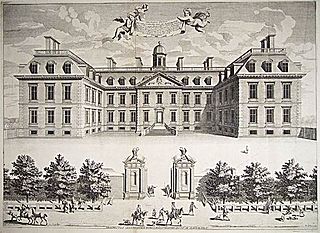
Sir Roger Pratt was an English gentleman-architect of the 17th century. He designed only five known buildings, but was highly influential, establishing a particularly English type of house, which was widely imitated. He drew on a range of European influences, and also on the work of Inigo Jones, England's first classical architect. Pratt also served on official commissions, and in 1668 was the first English architect to be knighted for his services.
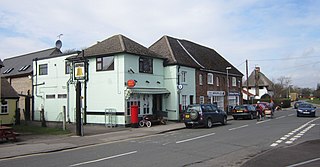
Bottisham is a village and civil parish in the East Cambridgeshire district of Cambridgeshire, England, about 6 miles (10 km) east of Cambridge, halfway to Newmarket. According to the 2001 census it had a population of 1,983, including Chittering, increasing to 2,199 at the 2011 Census.
Sir Giles Alington was a knight; Lord of the Manor of Horseheath, Cambridgeshire; and High Sheriff and MP for Cambridgeshire.

Pampisford is a village, south of Cambridge, on the A505 road near Sawston, Cambridgeshire, England.
Sir Richard Gardiner was, in 1478, elected Lord Mayor of London. He was Alderman of Walbrook Ward, and had been Sheriff of the City of London in 1469. He was also elected in 1478 a Member of Parliament for the City of London, one of the two aldermanic representatives of the city.
Sir William Coningsby was an English Member of Parliament and a Justice of the King's Bench.

Mundford is a village and civil parish in the English county of Norfolk. It is situated at the intersection of two major routes, the A134 Colchester to King's Lynn road and the A1065 Mildenhall to Fakenham road, about 8 miles (13 km) north west of Thetford. The village is 35 miles (56 km) from the city of Norwich and 88 miles (142 km) from London.

Cyril Argentine Alington was an English educationalist, scholar, cleric, and author. He was successively the headmaster of Shrewsbury School and Eton College. He also served as chaplain to King George V and as Dean of Durham.
This is an incompletelist of Sheriffs of Cambridgeshire and Huntingdonshire in England from 1154 until the abolition of the office in 1965.
Sir Thomas Hatton, 1st Baronet was an English politician who sat in the House of Commons of England variously between 1621 and 1640.
William Alington or Allington may refer to:
Sir Thomas Hatton, 2nd Baronet was an English politician who sat in the House of Commons from 1674 to 1679.
The Reverend Henry Giles Alington was an English clergyman and cricketer.











